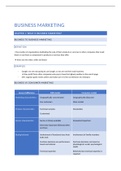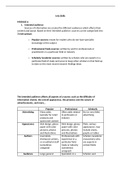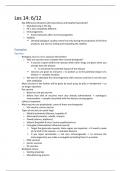Brief history
The fall in transportation and communication costs led not only to a large single market for many
industries, but also to a rise in competition, since firms now had to compete with more distant rivals,
located both in the other American states and abroad. The large investments made by firms so as to
enjoy scale and scope economies caused lower costs and lower prices.
Farmers and small businesses had enough political force and public sympathy to lead to the creation
of anti-trust laws in many US states (this still was ineffective if it involved agreements between
different states). Soon the Sherman act was adopted.
Relevant sections of this Sherman act:
- Section 1: Prohibits contracts, combinations and conspiracies which restrain trade, and prescribes
imprisonment and fines for violators.
- Section 2: Prohibits monopolization, attempts to monopolize and conspiracies to monopolize “any
part of the trade or commerce among the several states, or with foreign nations” (but not that
having a monopoly position in itself is not illegal)
The Clayton act was introduced in 1914 to extend the anti-trust legislation to cover mergers capable
of reducing competition, it was probably the Sherman act itself that led to a sharp increase in the
number of mergers in the US. The clayton act also forbids other practices, such as price
discrimination. Also in 1914, Federal Trade commission act, which shared with the Department of
Justice, the responsibility to enforce anti-trust law in the US at the federal level.
The inter-war period: This period is marked by a less strong enforcement of anti-trust laws.
Until the Mid 70-s: There was a period of intense anti-trust activity.
The joint effect of the Chicago school critique and of the loss of competitiveness of US firms abroad,
that directed attention to the efficiency effects of business practices, caused a change in the
enforcement attitudes of anti-trust law in the US.
Germany: For a long time the prevailing view was that cartels were an instrument to control the
instability created by cutthroat competition and price warfare. Only later, after a long debate, the
federal cartel office was the main institution called to enforce the rules against price-fixing
agreements and other anti-competitive practices.
Europe: One of the main objectives in European competition policy is the elimination in the economic
system of any discrimination based on national grounds. 2 other main objectives: Economic
efficiency and European market integration. Small and medium-sized enterprises (SMEs) often
receive favorable treatment in Europa.
Objectives of competition policy
Economic welfare
This is the standard concept used in economics to measure how well an industry performs.
Total surplus: The sum of consumer surplus and producer surplus.
Consumer surplus: Is given by the difference between the consumer’s valuation for the good
considered and the price, which effectively she has to pay for it. Consumer surplus or consumer
welfare is the aggregate measure of the surplus of all consumers.
Producer surplus: Is the sum of all profits made by producers in the industry.
,Welfare is lowest when the market price equals the monopoly price and highest when it equals
marginal costs of production.
Why consumer surplus?
- Attaching a heavier weight to consumer surplus than to producer surplus might help redress the
balance towards consumers.
- The merging firms enjoy information advantages over the competition authority, and the adoption
of a consumer welfare standard might counter-balance this asymmetry.
- It might simplify decisions by the anti-trust authorities in merger cases.
Why not (only) consumer surplus focus?
- Does not take into account the gains made by the firms.Consumers often own firms or have shares
in firms, if the adoption of a consumer welfare standard were intended to favor citizens as opposed
to firms, it would not be clear that such a goal would be achieved.
- This would lead to pricing at marginal costs, with firms exiting the industry in the long-run or having
to be subsidized to cover fixed costs.
- Lower prices and profits would have the effect of depriving firms from the necessary incentives to
innovate, invest, and introduce new products.
Small firms
The European commission seems to have taken the view that small and medium-sized enterprises
are more dynamic, more likely to innovate and more likely to create employment than large firms.
However, artificially helping small firms to survive when they are not operating at an efficient scale of
production is in contrast with economic welfare objectives. Smaller firms are often hurt by the lack of
proper infrastructure and imperfect markets. Such difficulties had better be dealt with by
government interventions at the root of the problems, rather than instruments such as competition
policy.
Antidumping laws: Laws that in theory aim at preventing foreign firms form selling below their costs
in the national market to the detriment of national firms.
Competition policy (or anti-trust policy): The set of policies and laws which ensure that competition
it he marketplace is not restricted in a way that is detrimental to society.
The book defines it as: The set of policies and laws which ensure that competition in the marketplace
is not restricted in such a way as to reduce economic welfare.
Horizontal agreements, that is agreements among competitors, usually restrict competition and thus
reduce welfare and should therefore be prohibited apart from very specific cases.
Vertical agreements, that is agreements between firms operating at different stages of the
production processes are often efficiency enhancing and pose problems to competition if any, only
when they are undertaken b firms which enjoy considerable market power.
An abuse of dominant position exist when a firms has a dominant position and when this dominant
firm has engaged into an abusive behavior.
Dominant position: Relates to a position of economic strength enjoyed by an undertaking, which
enables it to prevent effective competition being maintained on the relevant market by affording it
the power to behave to an appreciable extent independent of its competitors, its customers and
ultimately of the consumers.
3 outcomes to a merger request reported to the merger task force (MTF):
- Allowed
- Prohibited: Only mergers which create or reinforce a dominant position will be prohibited.
- Allowed subject to certain conditions
, Chapter 2 Market Power and Welfare
There is generally an inverse relationship between market power (the ability of firms to set prices
above marginal costs), of which monopoly power is the most extreme form, and (static) welfare.
In short:
1) Competition policy is not concerned with maximizing the number of firms
2) Competition policy is concerned with defending market competition in order to increase
welfare, not defending competitors.
Competition policy is not concerned with monopolies per se, but rather only with monopolies which
distort the competitive process. (A firm which enjoys a monopoly after having successfully invested
in, innovated, and introduced new products, is a firm which receives a reward for its activities).
Market power: It refers to the ability of a firm to raise price above some competitive level – the
benchmark price – in a profitable way.
Rent seeking: When monopolies are allowed, firms might try to use their political influence and
lobbying power to keep or increase their monopoly power. Pogingen om meer winst te krijgen dan de
uitkomst van complete competitie te bieden heeft.
3 assumptions by Posner:
- There exists perfect competition among agents who engage in rent-seeking activities.
- The rent-seeking technology is characterized by constant returns to scale.
- The costs incurred in obtaining a monopoly do not have any socially valuable by-products.
Allocative inefficiency: When for given production costs a monopolist charges too high a price,
leading to a welfare loss.
Productive inefficiency: If a firm operating under monopoly has a higher cost than if it were
operating in more competitive environments.
It does seem reasonable to claim that a firm that does not face any competitive pressure will not
make much effort to use the best available technologies, to improve its products and to innovate,
but one should look more carefully at the theoretical and empirical arguments that support this
claim.
Two main argument which suggest that a monopoly is likely to involve productive inefficiency:
- Managers have less incentive to make effort.
- The market will not operate any selection and an inefficient firm is as likely to survive as an
efficient one. (Darwinian selection argument)
Principal-agent models: Models where a principal wants to induce an agent to take the actions that
maximize her (the principal’s) payoff.
Managerial slack: The lack of managerial efficiency (for instance, in cutting costs) that occurs when
firms are insulated from competition. For example a manager who cares more about his wage and
career.
Overall, it seems that empirical studies confirm the important role played by competition in selecting
the most efficient firms and thus raising productive efficiency (entry and exit). If less efficient firms
were protected or subsidized, this would prevent market competition from selecting the best firms,
which will actually result in higher prices and lower welfare.












